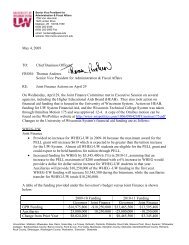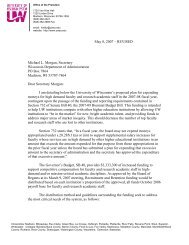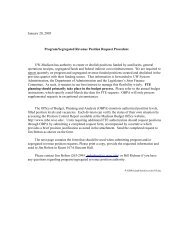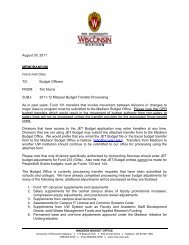Final Fund Consolidation Memo for FY13 - Madison Budget Office
Final Fund Consolidation Memo for FY13 - Madison Budget Office
Final Fund Consolidation Memo for FY13 - Madison Budget Office
Create successful ePaper yourself
Turn your PDF publications into a flip-book with our unique Google optimized e-Paper software.
NACUBO Financial Accounting and Reporting Manual (Sept. 2011)<br />
703.11 Auxiliary Enterprises, Auxiliary Enterprises—Other, and Other Self-<br />
Supporting Enterprises<br />
An auxiliary enterprise exists to furnish goods or services to students, faculty, staff,<br />
other institutional departments, or incidentally to the general public, and charges a fee<br />
directly related to, although not necessarily equal to, the cost of the goods or services.<br />
The distinguishing characteristic of an auxiliary enterprise is that it is managed to<br />
operate as a self-supporting activity. Over time, the revenues will equal or exceed the<br />
expenses, although in any individual year there may be a deficit or a surplus. Examples<br />
are residence halls, food services, intercollegiate athletics (if operated as essentially<br />
self-supporting), college stores, faculty clubs, parking, and faculty housing. Student<br />
health services, when operated as an auxiliary enterprise, also are included. Hospitals,<br />
although they may serve students, faculty, or staff, are classified separately because of<br />
their financial significance.<br />
The auxiliary enterprise category includes all expenses relating to the operation of<br />
auxiliary enterprises. Because of a desire to assess whether the enterprise is selfsupporting,<br />
an allocation of expenses <strong>for</strong> operation and maintenance of plant,<br />
depreciation, interest, and administration is included, even though that allocation is not<br />
required of public institutions <strong>for</strong> financial statement purposes. (Independent<br />
institutions, however, are required to make the allocation.) Also included are other<br />
direct and indirect costs, whether charged directly as expenses or allocated as a<br />
proportionate share of costs of other departments or units. To ensure that data regarding<br />
individual auxiliary enterprises are complete and adequate <strong>for</strong> management decisions,<br />
cost data should be prepared using full costing methods. Full costing means that the<br />
costs attributed to each enterprise includes a portion of indirect costs related to that<br />
enterprise, as well as the costs directly attributable to its operation.<br />
The auxiliary enterprise classification includes the following seven subclasses:<br />
· Auxiliary Enterprises—Student<br />
· Auxiliary Enterprises—Faculty/Staff<br />
· Intercollegiate Athletics<br />
· Auxiliary Enterprises—Other<br />
· Other Self-Supporting Enterprises<br />
· Auxiliary Enterprises—Depreciation<br />
· Auxiliary Enterprises—In<strong>for</strong>mation Technology<br />
703.111 Auxiliary Enterprises—Student - This subclass includes expenses <strong>for</strong><br />
auxiliary enterprise activities primarily intended to furnish services to students. A<br />
student health service, when operated as an auxiliary enterprise, is included. However,<br />
intercollegiate athletics are excluded from this category.<br />
703.112 Auxiliary Enterprises—Faculty/Staff - This subclass includes expenses <strong>for</strong><br />
auxiliary enterprise activities primarily intended to provide a service to the faculty,<br />
staff, or both. Such activities include the faculty club, faculty-staff parking, and faculty<br />
housing.









